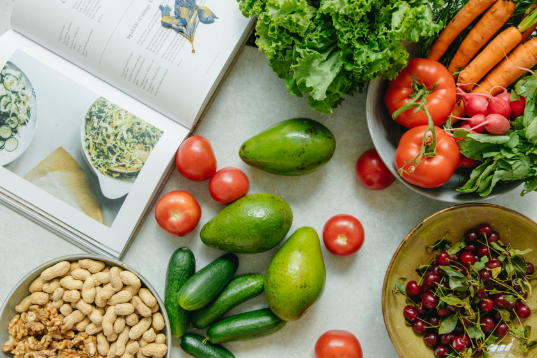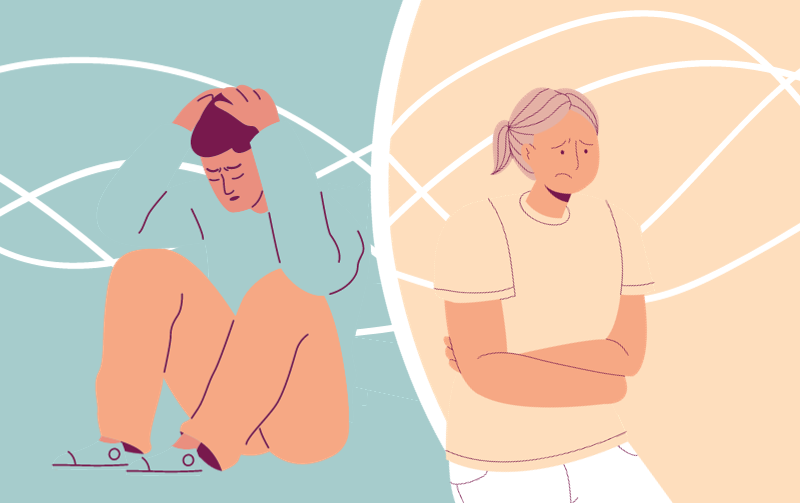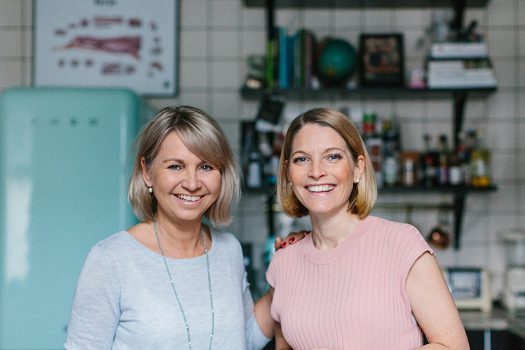
FODMAP – Your Guide to Foods to Eat or Avoid
By learning which foods upset your stomach, you can make conscious choices and get quick symptom relief. With the low FODMAP diet, you receive structured assistance in understanding which foods your body tolerates better than others. No more guessing and pondering – you get the answer straight away!
FOD… what? Have you also encountered question marks when mentioning FODMAP? Perhaps you’ve read that there’s nothing that helps with IBS. Why is that? IBS is a diagnosis surrounded by myths and misconceptions. There hasn’t been a proper treatment before, and we’ve been stuck in the belief that there never will be. We now know that this is incorrect! The low FODMAP diet helps 75% of all those with IBS.
Here's how FODMAP works
FODMAP is an acronym that stands for Fermentable, Oligo-, Di-, and Monosaccharides, and Polyols. These are fermentable carbohydrates. The low FODMAP diet originates from Monash University in Australia, where it has been researched by doctors and dietitians and has been used since 2005.
Dietitian Sofia Antonsson has implemented the low FODMAP diet in Swedish healthcare, and today, most dietitians use it. What people with IBS have in common is that FODMAPs are not fully absorbed. Instead of being properly digested and absorbed, they become fast food for our gut bacteria, which have a feast in the colon. This process leads to the formation of gases and affects the fluid balance, causing classic IBS symptoms.
FODMAP is divided into four categories:
Fructose: Found in certain fruits and vegetables, such as mango, and in honey.
Lactose: Milk sugar, present in dairy products from cow, sheep, and goat.
Oligosaccharides: Dietary fibre found in, among other things, peas, beans, onions, garlic, wheat, barley, rye, beets, and artichokes.
Polyols: Sweeteners in chewing gum and lozenges, naturally occurring in, for example, cauliflower and mushrooms.
The low FODMAP diet
The low FODMAP diet is conducted in several stages, commencing with the maintenance of a food and symptom diary to identify what and how you eat and how your symptoms manifest. You can learn more about this when following the treatment in our Belly Balance app.
Stage 1 – Initiates with an elimination phase lasting at least two and preferably four to six weeks, depending on how the symptom pattern changes. It’s crucial to allow sufficient time for the initial treatment, as it may take weeks, and sometimes months, for the stomach to settle.
Stage 2 – Involves the reintroduction of restricted foods in a specific order and in defined quantities.
Stage 3 in the treatment is the most important, focusing on the reintroduction of “non-permitted” foods. The purpose of reintroduction is to identify which foods are better tolerated, avoiding unnecessary exclusions. After reintroduction, you will know precisely which foods you handle better than others. This simplifies life, allowing you to choose when you might want or need to consume more FODMAPs.
We know, having assisted over 10,000 people with IBS, that the low FODMAP diet is the most effective method we have today. You work in a structured, controlled manner at a pace that feels comfortable. This is to ensure both your body and mind can keep up. That’s when things go well, and your stomach becomes calm and content!
Sofia Antonsson
Reg. Dietitian, Belly Balance
Frequently asked questions about the low FODMAP diet
Can I never again eat foods with FODMAPs again?
Absolutely! The idea behind the elimination phase is to reset the stomach, and then it’s the amount of FODMAPs per day that matters for symptom development. As you progress through the dietary treatment, during the reintroduction phase, you will understand precisely which foods you react more or less to.
I haven't been diagnosed with IBS, can I still try the low FODMAP diet?
Yes, if you don’t have any alarm symptoms (see below), it is safe to try dietary treatment. However, it is recommended to do it with the guidance of a dietitian familiar with the low FODMAP diet. If you haven’t undergone a gluten test, we recommend doing so before starting the dietary treatment.
Who should not use the low FODMAP diet?
Some symptoms, called alarm symptoms, are not typical for IBS, such as blood in the stool, fever, or involuntary weight loss. If you have any of these, you should not start the low FODMAP diet without consulting a doctor for further investigation. You may be affected by Crohn’s disease or ulcerative colitis.
My stomach got better without bread, am I gluten intolerant?
No, it’s common to think that gluten is the cause of gas in the stomach and bloating, but it’s not! It’s the fibres in grains that ferment in the stomach and create IBS symptoms. By removing grains and then gradually reintroducing them, most people can eat a smaller amount, especially in sourdough bread.
Is the low FODMAP diet a quick fix?
Unfortunately, FODMAP and quick fix don’t go together, not at all! Firstly, it takes time to understand what you can eat and not. Then there’s the issue of stress that affects the stomach and also needs to be addressed.
Isn't it called foodmap or food mapping?
A common misunderstanding is to think that it’s called foodmap or food mapping instead of FODMAP. It’s not surprising that this confusion arises since the treatment of IBS, to some extent, involves mapping out one’s diet. But, as we have learned in this article, FODMAP is indeed an acronym for Fermentable, Oligo-, Di-, and Monosaccharides, and Polyols, which are fermentable carbohydrates that are best avoided if you have IBS.
Can I follow the low FODMAP diet as a vegetarian?
It’s hard to miss the current strong trend toward vegetarianism. But what if you want to follow a vegetarian FODMAP diet? It’s not entirely straightforward, but it’s definitely doable with a bit of research and creativity! We’ve gathered tips for those following a vegetarian FODMAP diet who want to learn more about optimising protein and nutrient intake.
Difficult to understand the low FODMAP diet?
We sometimes meet both doctors and dietitians who don’t quite understand what the low FODMAP diet is all about. With all due respect, it’s not a simple method but requires expertise. However, with a little training, the results are excellent, and we get satisfied and happy patients. And the best part is that we deal with dietary treatment here, not medication primarily.
The low FODMAP diet is indeed a disease-specific dietary treatment that should only be performed by dietitians. That’s the case worldwide. The treatment is advanced and requires nutritional expertise, meaning understanding the body and nutrition. It may, at first glance, seem easier than it is, but anyone who has tried it knows that it’s a significant and time-consuming task.
App for the low FODMAP diet
In the Belly Balance app, you’ll find FODMAP lists, recipes, barcode scanner, IBS treatment, and much more to help you manage and minimise IBS symptoms.
Is there a FODMAP list with foods that are good for the stomach?
By becoming a member, you gain access to our FODMAP list, which is continuously updated with new ingredients, products, and shopping lists. Unfortunately, a small mistake can prevent the desired result. Therefore, we constantly update the lists in the app based on the analyses conducted on foods.
Does everyone with IBS benefit from the low FODMAP diet?
Scientific studies show that a whopping 75% of all people with IBS are helped by the low FODMAP diet. With the right help, you should experience symptom improvement within 2-4 weeks. For people with a severe form of IBS or with a high level of stress, it may take longer to see results.
Is the low FODMAP diet a low carb diet?
No, the low FODMAP diet is about avoiding fermentable carbohydrates and keeping the part of carbohydrates that doesn’t cause symptoms. The low FODMAP diet is not a diet but a dietary treatment.
Do I need to read the ingredient list?
Yes, it is absolutely necessary to learn which words signal FODMAPs. To make it easier, it’s good to eat as clean food as possible. Ready-made meals and mixed products often contain additives with FODMAPs. Our barcode scanner quickly tells you if the product is good for your stomach.
I have Crohn's, can the low FODMAP diet help me?
Crohn’s is a chronic, autoimmune disease that should always be treated in consultation with a doctor. However, research suggests that patients with both Crohn’s and Ulcerative colitis can experience symptom relief with FODMAP treatment. This is because some of the symptoms are the same as in IBS and are therefore positively affected with FODMAPs.
Do I have IBS or gluten intolerance?
First and foremost, let’s differentiate between gluten intolerance, gluten sensitivity, and IBS. In the case of gluten intolerance, antibodies against the gluten protein are detected in the blood through a blood test, leading to the diagnosis of gluten intolerance or celiac disease. Celiac disease affects approximately 1-2% of the population in Sweden and the USA, and the treatment involves a strict gluten-free diet for life.
Gluten sensitivity is a recognised term and phenomenon today, especially in the USA. It means that individuals who do not show antibodies against gluten still experience issues with the protein.
IBS, or Irritable Bowel Syndrome, is a functional gastrointestinal disorder, meaning that no abnormalities can be found in the stomach or intestines; they simply don’t function quite as they should. Approximately 15-20% of the world’s population has IBS, and the primary treatment for IBS is the FODMAP dietary approach.
Myths about the low FODMAP diet
You may have come across comments like:
Balance the gut flora, and you’ll get rid of your IBS! Well, yes, you can do that. The problem is that significant changes in diet and lifestyle are required before you can see any changes in the gut flora. Moreover, many foods that are good for gut bacteria can strangely cause symptoms for those with IBS, such as inulin in Jerusalem artichoke, onion, and garlic.
Don’t eat so much junk food! Well, it’s not optimal to indulge in hamburgers or pizza, but the fact is that healthy foods like avocado, beetroot, cauliflower, and mushrooms are packed with FODMAPs that can upset the stomach. So, the solution isn’t to start eating more of these either.
I’ve learned what I can eat and not eat. Good, but is your stomach calm now? Well, often not. It’s extremely challenging to connect symptoms with the right foods on your own.
It’s individual what you can eat with IBS. No, it’s actually not, at least not initially. The vast majority of people with IBS react to onions, garlic, grains, and lactose. That’s why FODMAP helps 75% of all people with IBS. Then there are individual variations, and you’ll notice that when you start reintroducing foods.
The low FODMAP diet in the Long Run
Studies consistently show a good effect of consuming fewer FODMAPs for those with IBS. However, an unintended consequence of following the dietary treatment is an impact on the gut flora. It has been observed that the amount of beneficial gut bacteria decreases, especially in the early stages of the dietary treatment when the restriction is greatest. Therefore, it is extremely important to complete the ENTIRE treatment with a dietitian who understands the treatment and knows how to manage FODMAPs in the long run.
Take control of your IBS today!
Ready to reclaim your life from IBS? Our app provides the tools and guidance you need to manage IBS effectively.
Download the App



